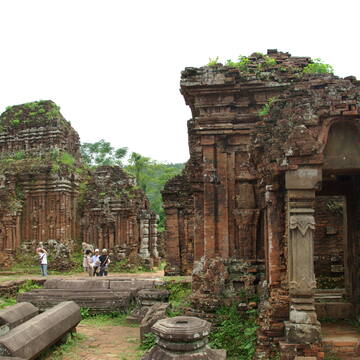My Son Hindu temple, Vietnam

Address
My Son Hindu temple, Vietnam, The world cultural heritage My Son Thôn, Mỹ Sơn, Duy Xuyên, Quảng Nam, Vietnam
Diety
Shiva, Bhadraveshwaran
Introduction
Mỹ Sơn is located near the village of Duy Phú, in the administrative district of Duy Xuyên in Quảng Nam Province in Central Vietnam, 69 km southwest of Da Nang, and approximately 10 km from the historic Champa capital of Trà Kiệu. The temples are in a valley roughly two kilometers wide that is surrounded by two mountain ranges. Mỹ Sơn is perhaps the longest inhabited archaeological site in Indochina, but a large majority of its architecture was destroyed by the US bombing during a single week of the Vietnam War. From the 4th to the 14th century AD, the valley at Mỹ Sơn was a site of religious ceremony for kings of the ruling dynasties of Champa, as well as a burial place for Cham royalty and national heroes. It was closely associated with the nearby Cham cities of Indrapura (Đồng Dương) and Simhapura (Trà Kiệu). At one time, the site encompassed over 70 temples as well as numerous stele-bearing historically important inscriptions in Sanskrit and Cham. Explore the cultural center of the ancient Champa Kingdom and the ruins of the Hindu temples of Mỹ Sơn. Discover beautiful carvings and the fascinating history of one of the most important archeological sites in Indochina. Mỹ Sơn is often compared to Angkor Wat in Cambodia or Borobudur in Java. The ancient religious site and burial place of Cham royalty consists of several groups of temples. 70 temples and tombs dedicated to Shiva were severely damaged by the war. Craters made by bombs during the Vietnam War are still visible here, some of them right next to the buildings. The ruins are nestled in a valley among the mountains of Quang Nam Province.
Puranic Significance
During the 4th to 13th centuries, there was a unique culture on the coast of contemporary Vietnam, owing to its spiritual origins to the Hinduism of India. This is graphically illustrated by the remains of a series of impressive tower temples in a dramatic site that was the religious and political capital of the Champa Kingdom for most of its existence. My Son Sanctuary dates from the 4th to the 13th centuries CE. The property is located in the mountainous border of Duy Xuyen District of Quang Nam Province, in central Viet Nam. It is situated within an elevated geological basin surrounded by a ring of mountains, which provides the watershed for the sacred Thu Bon river. The source of the Thu Bon river is here and it flows past the monuments, out of the basin, and through the historic heartland of the Champa Kingdom, draining into the South China Sea at its mouth near the ancient port city of Hoi An. The location gives the sites its strategic significance as it is also easily defensible. The tower temples were constructed over ten centuries of continuous development in what was the heart of the ancestral homeland of the ruling Dua Clan which unified the Cham clans and established the kingdom of Champapura (Sanskrit for City of the Cham people) in 192 CE. During the 4th to 13th centuries CE this unique culture, on the coast of contemporary Viet Nam, owed its spiritual origins to the Hinduism of the Indian sub-continent. Under this influence, many temples were built to the Hindu divinities such as Krishna and Vishnu, but above all Shiva. Although Mahayana Buddhist penetrated the Cham culture, probably from the 4thcentury CE, and became strongly established in the north of the kingdom, Shivite Hinduism remained the established state religion. The monuments of the My Son sanctuary are the most important constructions of the My Son civilization. The tower temples have a variety of architectural designs symbolizing the greatness and purity of Mount Meru, the mythical sacred mountain home of Hindu gods at the center of the universe, now symbolically reproduced on Earth in the mountainous homeland of the Cham people. They are constructed in fired brick with stone pillars and decorated with sandstone bas-reliefs depicting scenes from Hindu mythology. Their technological sophistication is evidence of Cham’s engineering skills while the elaborate iconography and symbolism of the tower-temples give insight into the content and evolution of Cham’s religious and political thought. The My Son Sanctuary is a remarkable architectural ensemble that developed over a period of ten centuries. It presents a vivid picture of spiritual and political life in an important phase of the history of South-East Asia. The monuments are unique and without equal in Southeast Asia.
Special Features
The Hindu tower temples of the My Son Sanctuary are located within a well-protected property with clearly defined boundaries. Eight groups of 71 standing monuments exist as well as extensive buried archaeology representing the complete historic sequence of construction of tower temples at the site, covering the entire period of the existence of the Champa Kingdom. Conservation of the My Son monuments began in the early part of the 20th century CE soon after their discovery in modern times by French archaeologists. During World War II, the First Indo-China War, and, especially, during the Second Indo-China War, many tower temples were damaged. However, conservation work has been carried out and the remaining tower temples have been maintained and are well-preserved. The site is at risk from severe climatic conditions such as flooding and high humidity, though stream widening and clearance of surrounding vegetation have minimized these impacts. There remains an enduring issue of the possible presence of unidentified, unexploded ordnance within the boundaries of the property’s buffer zone, which has affected the archaeological research of newly-discovered areas, restoration of eight monumental areas, as well as site presentation for visitors.
Century/Period/Age
AD 14th Century
Managed By
UNESCO World Heritage Site
Nearest Bus Station
Vietnam
Nearest Railway Station
Vietnam
Nearest Airport
Tan Son









